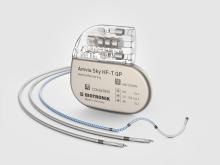Unveiling Hidden Atrial Fibrillation: Implications for Stroke Prevention in ICD Patients
New Research Confirms Effective Tools to Better Protect Patients with High Stroke Risk

Stroke prevention is of paramount importance in healthcare, especially considering the aging population and the burden of atrial fibrillation (AF) on healthcare systems.1 The 2020 European Society of Cardiology (ESC) guidelines recommend integrated AF management by multidisciplinary teams, prioritizing the “ABC pathway” and anticoagulation for stroke prevention.1 However, the often asymptomatic nature of AF poses challenges in timely diagnosis and treatment,1 emphasizing the need for early detection methods to mitigate stroke risks and potentially improve patient outcomes.
We spoke with electrophysiologist Dr. Giampiero Maglia, Catanzaro, Italy, on the implications of AF for stroke prevention. He is one of the authors behind the MATRIX study, which examined the effectiveness of single-lead implantable cardioverter-defibrillators (ICDs) with an atrial sensing dipole (DX ICD system) in combination with remote care to adequately detect and monitor AF.
On World Stroke Day, we delved into the study and explored how its findings might help clinicians optimize stroke prevention strategies and safeguard those at high risk.
A Risk Population That Is Not Adequately Managed
AF is associated with an up to fivefold increase in the risk of stroke, up to 3.5-fold higher all-cause mortality, and congestive heart failure in 20–30% of patients.1 The MATRIX study showed that the new onset of atrial high-rate episodes (AHRE) is not rare. Within the two years of follow-up, 8.2% of patients without a former history of AF experienced new-onset AHRE and 31.1% of them a progression to a stratum of longer duration, for example from 6 min–1 hr to 1 hr–24 hrs.2 Additionally, nearly 80% of new-onset AF patients had high CHA2DS2-VASc stroke risk, and 70% of them were not on anticoagulation therapy.2
“These patients were not receiving anticoagulation therapy, but had a high CHA2DS2-VASc score – indicating an increased risk of stroke,” explains Dr. Maglia, who points out that the MATRIX study “showed us that there is a population at higher risk of stroke that is not adequately managed. As the study has shown, these patients can benefit from a guideline-conform monitoring strategy to timely initiate anticoagulation for stroke prevention.”
The Best Treatment Strategies
The European AF guidelines1 recommend considering oral anticoagulation (OAC) for patients with elevated risk for stroke and with longer durations of subclinical AF, such as episodes lasting more than 24 hours with high monthly burden or more than one hour with high daily burden. However, individual risk assessment, anticipated net clinical benefit and patient preferences should be considered when making decisions about anticoagulation therapy.
“By implementing comprehensive treatment strategies, including appropriate anticoagulation therapy and optimized pharmacological interventions, we can proactively prevent strokes and minimize the burden of heart failure. This emphasizes the significance of tailored management approaches for individuals with atrial high-rate episodes and underscores the importance of comprehensive stroke prevention measures," says Dr. Maglia.
Respectively, the diagnostic data from DX ICDs not only helps to identify patients at risk for stroke, but also plays a crucial role in determining the optimal timing to initiate oral anticoagulation therapy (OAC) as their AF burden becomes significant. “This valuable information further enhances our ability to provide targeted and timely interventions, adding another critical dimension to optimizing stroke prevention.”
Advanced Remote Monitoring Technologies
“Integrating advanced remote monitoring technologies to enhance AF detection allows for more comprehensive and continuous patient monitoring – with daily transmission as an important aspect of remote monitoring,” reports Dr. Maglia.
“It is crucial that we monitor ICD patients effectively according to the European AF guidelines via remote monitoring. The MATRIX study has shown that this is possible with a single-chamber ICD enhanced with a floating atrial sensing dipole, the DX ICD, in combination with Home Monitoring. And, we know that such device with only one lead can cause fewer potential complications – which is also an important factor to consider in ICD patients,” concludes Dr. Maglia.
DX Effectiveness Confirmed in a Real-Life Setting
The MATRIX2 study, the largest clinical evaluation of DX Technology, examined the effectiveness of the DX ICD system in monitoring atrial high-rate episodes (AHRE) and their progression. This international, multicenter registry included 2,054 DX-ICD patients across 119 sites in 24 countries. Over a span of 24 months, patients were closely monitored under real-life conditions, shedding light on the clinical implications of AHRE detection and progression.
DX Effectiveness Confirmed in a Real-Life Setting
The MATRIX2 study, the largest clinical evaluation of DX Technology, examined the effectiveness of the DX ICD system in monitoring atrial high-rate episodes (AHRE) and their progression. This international, multicenter registry included 2,054 DX-ICD patients across 119 sites in 24 countries. Over a span of 24 months, patients were closely monitored under real-life conditions, shedding light on the clinical implications of AHRE detection and progression.
References:
1. Hindricks G, Potpara T, Dagres N, Arbelo E, Bax JJ, Blomström-Lundqvist C et al. 2020 ESC guidelines for the diagnosis and management of atrial fibrillation developed in collaboration with the European Association for Cardio-Thoracic Surgery (EACTS): the task force for the diagnosis and management of atrial fibrillation of the European Society of Cardiology (ESC) developed with the special contribution of the European Heart Rhythm Association (EHRA) of the ESC. Eur Heart J 2021;42:373–498.
2. Hindricks G, Theuns DA, Bar-Lev D, et al. Ability to remotely monitor atrial high-rate episodes using a single-chamber implantable cardioverter-defibrillator with a floating atrial sensing dipole, EP Europace, Volume 25, Issue 5, May 2023, Pages 1–10, euad061.
Note: The content of this blog is based on research findings and should not replace individualized medical advice. It is recommended that you consult with a health care professional for personalized guidance and treatment decisions.
